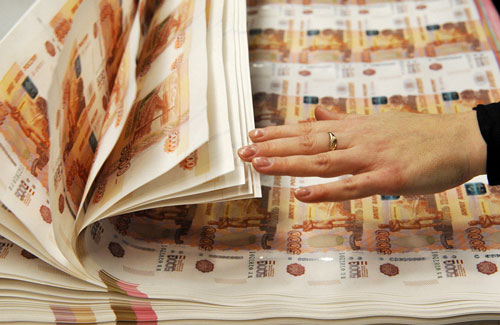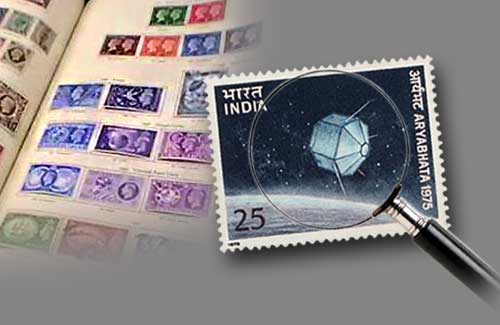Ashvamedha Coins of Samudragupta
To celebrate his victories in Northern and Southern India, Samudragupta performed the Ashvamedha sacrifice, probably late in his reign. He took pride in reviving the ritual and issued Ashvamedha coins in gold to commemorate the event. Numerous coins of this type have been found; 20 of them in the Bayana hoard itself. The diameter of these coins ranged from 19 to 23 mm while the weight varied from 112.5 to 119 grains. The average weight was 115 grains. The coins are found mostly in Patna and Sahranpur.The Obverse of the coin depicts the sacrificial horse standing before a yupa or a sacrificial post on a platform while the Reverse of the coins shows the crowned queen standing on a circular pearl-bordered mat with a chouri in her right hand and a towel in her left. A spear-like object can be seen in front of her.
The Ashvamedha coins commissioned by Samudragupta of Gupta dynasty are among the best of specimens in terms of numismatic art. The art displays high merit and great detail. The horse looks graceful and noble while the queen’s stance if slim and elegant. The horse is uncaparisoned in all coins; although, in some coins, a strap may be shown around its neck. Some coins show the horse with beads strung to the mane. The Vedic texts advise pleating the horse’s mane and tail with beads. The coins, however, do not depict a beaded and pleated tail. Each coin is inscribed with the Brahmi letter ?si’ placed under the horse. Experts who have studied these coins suggest that the letter stands for the word, 'siddha?'.
The platform over which the horse stands is called a vedi (altar). The base of the yupa is placed partially within the altar and partially outside. This is because the Taittiriya Samhita states that if the yupa is fixed entirely within the vedi, the sacrifice only wins within the world of gods. If the yupa is fixed entirely outside the vedi, the sacrificer only wins within the world of men. However, if it fixed partially outside and within the altar, it is believed that the sacrificer wins both worlds. Artistes have mostly shown the yupa to be fixed partially on the vedi and partially outside. A low pedestal above the platform can be seen on the vedi on a few rare coins.
The engravers were influenced by artistic consideration in addition to their regard for the sacred texts which is prominent in the presentation of the yupa. Penons of flying cloth depicted on the coins were not prescribed in the Vedas. This was the artist’s impression. Since the coins were small, the yupa staff could not be depicted as being eight-cornered, as described in the texts. However, it is shown to be bent in the middle and at the top, exactly as the Vedic texts prescribe.
The legend on the obverse of the coins read ? Rājādhirāja? prithvi? vijityadiva? jayatyāh?itavājmedha?.
The queen depicted on the reverse is shown to be holding a chouri in her right hand and a piece of cloth or a towel in her left. Rituals of the sacrifice required the queen to fan and wash the horse; hence, the depiction. The staff, in front of the queen was interpreted as a standard or a sacrificial spear. The sacrificial spear was not used for the Ashvamedha; and as the staff had no flag, it could not be regarded as a standard. Altekar concluded that it must be a ceremonial needle which was used, in accordance with the texts, by the queen.
Ashvamedha Coins of Kumaragupta I
There are no epigraphic mentions of Kumaragupta I of Gupta Empire having performed the Ashvamedha sacrifice. His coins, however, prove that at least one Ashvamedha sacrifice was performed by the king. Kumaragupta’s Ashvamedha coins are rare.
No epigraphic mention has been found so far that mentions the performance of the Ashvamedha sacrifice by Kumaragupta I. His coins, however, prove that at least one was performed by the king during his reign. The Ashvamedha coins issued by Kumaragupta I are rare and artistically inferior to those issued by Samudragupta. The horse on the obverse is caparisoned in some coins and yupa is crude. The queen’s figure on the reverse is stumpy, bent and fat. The Brahmi letter ?si’ is not seen under the horse. All coins weigh a standard issue of 127 grains. In Variety A of Kumaragupta’s Ashvamedha coins depict a caparisoned sacrificial horse facing right, while in Variety B, a bare-backed horse is seen facing left.
-
Stamps on International Refugee Day

Violence, wars, terrorist attacks and prosecutions have torn the world apart into pieces t...
-
Young Philatelist: Mythical Creatures on Stamps

Can you imagine a world without stories? We were all born to tell and listen to them; that...
-
Young Numismatist: Time to Show You The Money

You always cribbed “Show Me the Money”. Now you get to see me in person, nice, up and ...
-
Types of Fancy Number Currency Notes

Types of Fancy Number Currency Notes Many notes come and go from your pockets and wallets...
-
Essential Tools for Every Stamp Collector

Gearing up the right way for anything that you have set your minds on always comes in hand...
-
Celebrating Buddha Purnima Through Coinage

21st May will be observed as Buddha Purnima this year across the country, celebrating the ...
-
Why Can't a Country Choose to Get Richer By Printing More Paper Money?

A question that many of us might have thought of, but never knew whom to ask. Today, let�...
-
Remembering Rabindranath Tagore

7th May 1861 was a special day in Indian history indeed. Rabindranath Tagore, one of the w...
-
CM Devendra Fadnavis Launches Mintage World

23rd April 2016 was a very special and eventful day indeed! Mintageworld.com was officiall...
-
8 Tips for Budding Stamp Collectors

Collecting stamps is more than just a hobby for some. It’s an experience that helps you ...

